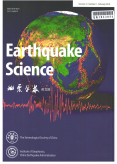- 钛学术文献服务平台 \
- 学术期刊 \
- 基础科学期刊 \
- 天文学、地球科学期刊 \
- 地震学报(英文版)期刊 \
null
Modeling the dynamic process of tsunami earthquake by liquid-solid coupling model
基本信息来源于合作网站,原文需代理用户跳转至来源网站获取
摘要:
Tsunami induced by earthquake is an interaction problem between liquid and solid. Shallow-water wave equation is often used to modeling the tsunami, and the boundary or initial condition of the problem is determined by the displacement or velocity field from the earthquake under sea floor, usually no interaction between them is considered in pure liquid model. In this study, the potential flow theory and the finite element method with the interaction between liquid and solid are employed to model the dynamic processes of the earthquake and tsunami. For modeling the earthquake, firstly the initial stress field to generate the earthquake is set up, and then the occurrence of the earthquake is simulated by suddenly reducing the elastic material parameters inside the earthquake fault. It is different from seismic dislocation theory in which the relative slip on the fault is specified in advance. The modeling results reveal that P, SP and the surface wave can be found at the sea surface besides the tsunami wave. The surface wave arrives at the distance of 600 km from the epicenter earlier than the tsunami 48 minutes, and its maximum amplitude is 0.55 m, which is 2 times as large as that of the sea floor. Tsunami warning information can be taken from the surface wave on the sea surface, which is much earlier than that obtained from the seismograph stations on land. The tsunami speed on the open sea with 3 km depth is 175.8 m/s, which is a little greater than that predicted by long wave theory, (gh)1/2=171.5 m, and its wavelength and amplitude in average are 32 km and 2 m, respectively. After the tsunami propagates to the continental shelf, its speed and wavelength is reduced, but its amplitude become greater, especially, it can elevate up to 10 m and run 55 m forward in vertical and horizontal directions at sea shore, respectively. The maximum vertical accelerations at the epicenter on the sea surface and on the earthquake fault are 5.9 m/2 and 16.5 m/s2, respectively, the later is 2.8 times the former, and therefore, sea water is a good shock absorber. The acceleration at the sea shore is about 1/10 as large as at the epicenter. The maximum vertical velocity at the epicenter is 1.4 times that on the fault. The maximum vertical displacement at the fault is less than that at the epicenter. The difference between them is the amplitude of the tsunami at the epicenter. The time of the maximum displacement to occur on the fault is not at the beginning of the fault slipping but retards 23 s.

推荐文章
期刊_丙丁烷TDLAS测量系统的吸收峰自动检测
带间级联激光器
调谐半导体激光吸收光谱
雾剂检漏 中红外吸收峰 洛伦兹光谱线型
不同盐度、温度及光照对漂浮浒苔生理生态的影响
浒苔
盐度
温度
光照
生理生态
期刊_联合空间信息的改进低秩稀疏矩阵分解的高光谱异常目标检测
高光谱图像
异常目标检测 低秩稀疏矩阵分解 稀疏矩阵 残差矩阵
内容分析
关键词云
关键词热度
相关文献总数
(/次)
(/年)
引文网络
引文网络
二级参考文献 (0)
共引文献 (0)
参考文献 (13)
节点文献
引证文献 (0)
同被引文献 (0)
二级引证文献 (0)
1926(1)
- 参考文献(1)
- 二级参考文献(0)
1952(1)
- 参考文献(1)
- 二级参考文献(0)
1979(1)
- 参考文献(1)
- 二级参考文献(0)
1985(1)
- 参考文献(1)
- 二级参考文献(0)
1990(1)
- 参考文献(1)
- 二级参考文献(0)
1991(1)
- 参考文献(1)
- 二级参考文献(0)
1995(3)
- 参考文献(3)
- 二级参考文献(0)
1998(1)
- 参考文献(1)
- 二级参考文献(0)
2003(2)
- 参考文献(2)
- 二级参考文献(0)
2005(1)
- 参考文献(1)
- 二级参考文献(0)
2008(0)
- 参考文献(0)
- 二级参考文献(0)
- 引证文献(0)
- 二级引证文献(0)
引文网络交叉学科
相关学者/机构
期刊影响力
地震学报(英文版)
主办单位:
中国地震学会
出版周期:
双月刊
ISSN:
1674-4519
CN:
11-5695/P
开本:
16开
出版地:
北京民族学院南路5号(北京8116信箱)
邮发代号:
创刊时间:
1980
语种:
eng
出版文献量(篇)
1366
总下载数(次)
0
期刊文献
相关文献
推荐文献
- 期刊分类
- 期刊(年)
- 期刊(期)
- 期刊推荐
力学
化学
地球物理学
地质学
基础科学综合
大学学报
天文学
天文学、地球科学
数学
气象学
海洋学
物理学
生物学
生物科学
自然地理学和测绘学
自然科学总论
自然科学理论与方法
资源科学
非线性科学与系统科学
地震学报(英文版)2022
地震学报(英文版)2021
地震学报(英文版)2020
地震学报(英文版)2019
地震学报(英文版)2018
地震学报(英文版)2017
地震学报(英文版)2016
地震学报(英文版)2015
地震学报(英文版)2014
地震学报(英文版)2013
地震学报(英文版)2012
地震学报(英文版)2011
地震学报(英文版)2010
地震学报(英文版)2009
地震学报(英文版)2008
地震学报(英文版)2007
地震学报(英文版)2006
地震学报(英文版)2005
地震学报(英文版)2004
地震学报(英文版)2003
地震学报(英文版)2002
地震学报(英文版)2001
地震学报(英文版)2000
地震学报(英文版)1999
地震学报(英文版)2008年第6期
地震学报(英文版)2008年第5期
地震学报(英文版)2008年第4期
地震学报(英文版)2008年第3期
地震学报(英文版)2008年第2期
地震学报(英文版)2008年第1期

 免费查重
免费查重










